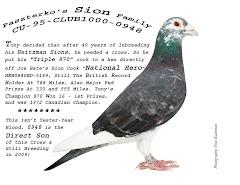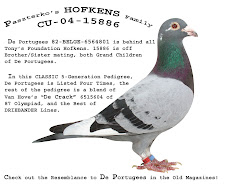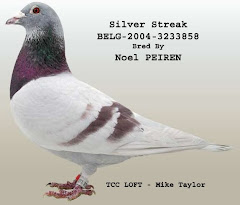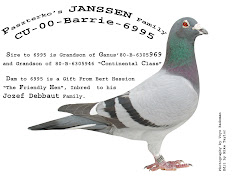by Earl Lowell Robbie aka "No Sweat" Robbins, Jr.
Its the biggest race of your life. You've done everything to create the perfect bird. You put Mendel to shame with your genetic prowess. The body and feather of your entry has been created for this exact race. You know exactly what type pigeon it will take to conquer this terrain, distance and the weather that's likely to be encountered. Moult, your bird makes Mona Lisa frown. Psychology, you are the father of Freud.
How smart are you about condition? A genius. Assuredly.
Maybe not.
Maybe there's another way of thinking. Thinking not new. Thinking you would have been exposed to if you were a collegiate athlete in swimming or track. Thinking that involves more than physiology. Thinking that's been adopted for training thoroughbreds. Training quite the cup of tea for any animal on a given day.
What is it like to walk one mile or swim 100 yards? If you do it over and over what happens to your body? What happens to your mind? What if you decide to run one mile or that 100 yards?
What is the best way to be your best?
Is your pigeon a pigeon?
Freud's father was never advertised for being too smart. But then, he might've been smarter than the ever so many genius' roaming within our sport that look upon a poor pigeon as some kind of locomotive constant. Something you can train over and over at the same distance. Your little locomotive.
That pigeon ain't no pigeon?
To get the best from a racing pigeon it should have that perfect body, feather, eye and disposition. Oddly enough, the same can be said for humans.
If you are in some sort of training schedule and you run a five miles every day or if you are a pigeon and home 100 miles every day you may eventually be great at what you do but when can you be your very optimum best?
Strange and mindless. I suppose sums up humans. Freud concerned himself over such. When it comes to racing pigeons, it shines.
A pigeon is decidedly not a pigeon.
After you turn that pigeon into your artistic F-15 how can you get it to do its absolute best?
Of course. But you need to have an edge over love. Love can move mountains but it might not win a race.
Somewhere down the line you have either developed a sixth sense about pigeons or you haven't. Unfortunately, most of the fanciers I've stumbled upon do well to have five senses, let alone this sixth.
If you are a sheik and come to America and buy the best yearlings down from Seattle Slew, Alyadar, Unbridled, Curlin and company, and think that's all it will take to win the Kentucky Derby--- that and locomotive training, then you will sadly learn as so man sheiks have already experienced, it ain't that simple.
Are you one of those fliers training birds 20 to 100 miles every day believing that doing such will have your birds perfect come that one great race?
Taint so.
That kind of thinking and that kind of psychology puts Freud's father a genius in comparison to your wretched brain.
There is a method of training called, tapering. Tapering is not a method wherein a human or pigeon is trained to do the same thing over and over day in and day out and on any given day be its best. It is in fact a method that explores and utilizes a certain discipline and understanding of all things possible. And in this understanding, if done just so, you actually do have a given day or a given time frame wherein you or your pigeon can be at your optimum best.
And yes, there are exceptions to everything. I suppose, even exceptions to tapering. On given events, I've observed humans, horses and pigeons winning and in review of their training there was no tapering involved.
But then, that same person, horse or pigeon may well have done even better than it did if it had been tapered just so.
In something physical you need to build up to that point you are hoping to achieve. This involves a gradual increase going from a beginning to that pinnacle of where you want to go. I was a distance swimmer in college, training with 15 ALL AMERICANS for four years. I was as green as grass when I came there. Didn't know a thing about tapering.
But my swim coach, Don Combs, the son of Earle Combs, the famous Hall Of Famer that batted third on MURDERERS ROW for the NY Yankees after Babe Ruth and Lou Gehrig, for some reason, probably because I was a poor hillbilly like him, took me under his wing and after four years, instilled within me a seasoned knowledge of what tapering was all about and how it had no human boundaries.
I've also been around thoroughbreds for some fifty years and by some nefarious design fell into wagering on them. There was a point in my poor life where I thought I had a real handle on all there was to know about race horses. I can still remember betting $4,000 on Alyadar in The Kentucky Derby. Losing that bet was an expensive education.
I still love thoroughbreds. I still swim. And I still dwell at the track and breathe that same air that I did over a half century ago. I still read the form. And because I do study the form so closely, I've noticed several things regarding thoroughbreds that have evolved over the past fifty years. One is that now the breeding of thoroughbreds is centering far more on line-breeding than it ever once did. In years past, you rarely saw such concentration on certain blood. And two, its become obvious that many of the trainers are beginning to employ variations of tapering.
Mark Spitz could tell you about tapering. So could Michel Phelps. Both used tapering to win to make them the best swimmers in the world. The way they handled tapering put them at their very best for a given time. They beat every swimmer in the world. It was no accident. It involved much preparation. And certainly, they were not locked into some mindless training wherein all they did day in or day out was the same routine.
Tapering is complex when studied on all fronts as it must encompass everything around you as well as the basics.
Basics is the nitty gritty. For racing pigeons, tapering could apply differently depending on when and what you want to achieve. Tapering could take on several faces. But allow me to explain some simple arrangement of understanding of tapering. Let's say there is going to be a 300 mile young bird race of great importance in November. Its that race you've known about for a year and would love to win. You know how to conquer all the issues of breeding, moult, etc but you really don't know anything about tapering.
To begin, you would want to circle the date of the race in your mind. If the race is on November 15Th you will have to time your training and tapering for that exact date. At some point you will have taken your young birds out for their first training toss and as time has gone by you will have them out as far as 100 miles, possibly farther. A series of training tosses increasing in distances could vary. For the sake of argument and a simple example allow me to hypothesize a basic outline you would want to employ. Let's baby these birds and take them on this toss-training-tapering schedule as best we can: 1st toss: 1 mile. 2nd toss: 5 miles. 3rd toss: 10 miles. 4th toss: 20 miles. 5th -- 6th toss: 30 miles. 7th toss: 20 miles. 8th- toss: 50 miles. 9th--10th toss: 60 miles. 11th toss: 20 miles. 12th toss 100 miles.
This is just one hypothetical schedule that starts out using a tapering training program to begin to get your birds in superior condition. You could adopt nearly any manner of distances you feel that are best suited for you just so long as you employ the basic theme of what tapering encompasses.
First, the basic concept involves gradually building your birds up by increasing distances. Sometimes you may want to stay at those distances to make certain that you are very strong at that level. Then, at some point, you will want to regress and go back, decreasing the distance. Alot happens when you do this. But basically it will normally cause the animal to have a little less pressure placed on it that day, Less energy output. And in the doing will cause a rather wonderful expansion in psyche and muscle development. Its almost the same principle in a round about way as your employer telling you that he's giving you a paid month's vacation and when you come back he expects you to tackle some tough assignments. And the truth is, it works. Surveys have proved that people who work four ten hour days are happier and more productive than people who work five eight hour days.
When it involves racing pigeons, what you must learn about tapering is how to build up to a distance, maintain that distance, come back down from that distance and then go on farther with the distance. Continuously building up and going back at all sorts of levels. Slowly but surely reaching new levels of endurance. Its a matter of timing and understanding and with racing pigeons you must always be astute, carefully handling and watching each bird. If a bird becomes weak or is in a heavy moult you must note such. If the sky turns dark and there is likely to be a downpour on a training day you have to back off and re-think your strategy.
Freud's father, Jacob, was a wool merchant. He lost his business because of the economic crisis of 1857. A crisis that led to our Civil War. A great many events led to this crisis. Events beyond Jacob's control. And yet, history records Freud's father at being basically unsuccessful.
Maybe Jacob would have done better if he had understood tapering.
But then, Jacob, in his despair, would've confessed, some pigeons are pigeons.
One of the favorite tactics that race horse trainers employ is to have their chosen horse that has been racing at 11/8 mile races on a regular basis to drop down in distance to a mile or even a six furlong race for a given race. As a handicapper, you must always pay careful attention when a trainer does this as so many times such a horse will win this shorter race. This all comes back to tapering. Even when trainers are aiming at The Kentucky Derby they will work their entries previous to the races with all manner of workouts and so many are either in the building up stage or the tapering down stage. Both involving the principles of tapering.
So what about that big 300 mile bookoo race that is going to put your handsome face on the cover of The Racing Pigeon Digest and have your racing pigeon soaring in every fancier's imagination?
If it were me, I would build the bird/s up to 100 miles something like I've mentioned. Then,depending on what the race schedule happened to be. I would employ that schedule to my design. If the race schedule didn't fit my plan, I would train the birds on my own at the distances and times that best benefited them. Once you reach 100 miles many things are possible. You might want to continue several tosses at that distances. You may want to go on up to 150 or 200 miles. You may even want to fly a 300 or a 350 or a 400. Flying a 300 prior the race and then tapering back down with ample rest would be an ideal situation. Tapering down before that bookoo 300. And throughout this tapering down, you would also want to assure that your birds were beautifully content and in love with their home. I would take up residence in the loft watching their every move, psychoanalyzing their every coo. During this tapering you would want to employ all your knowledge regrading the right types and amounts of feed, the right amounts of light that the birds should have while roosting-- controlling the darkness of the a loft in harmony with tapering can help achieve superior contentment of the birds as well as condition.
If tapering didn't produce winning results, athletes and thoroughbred trainers wouldn't use it. It remains rather amazing that so many racing pigeon fliers still own no concept of tapering and how to use the method. Locomotives may be locomotives but pigeons ain't pigeons.
Not unless you are a pigeon, too.
Ask Jacob.
Its the biggest race of your life. You've done everything to create the perfect bird. You put Mendel to shame with your genetic prowess. The body and feather of your entry has been created for this exact race. You know exactly what type pigeon it will take to conquer this terrain, distance and the weather that's likely to be encountered. Moult, your bird makes Mona Lisa frown. Psychology, you are the father of Freud.
How smart are you about condition? A genius. Assuredly.
Maybe not.
Maybe there's another way of thinking. Thinking not new. Thinking you would have been exposed to if you were a collegiate athlete in swimming or track. Thinking that involves more than physiology. Thinking that's been adopted for training thoroughbreds. Training quite the cup of tea for any animal on a given day.
What is it like to walk one mile or swim 100 yards? If you do it over and over what happens to your body? What happens to your mind? What if you decide to run one mile or that 100 yards?
What is the best way to be your best?
Is your pigeon a pigeon?
Freud's father was never advertised for being too smart. But then, he might've been smarter than the ever so many genius' roaming within our sport that look upon a poor pigeon as some kind of locomotive constant. Something you can train over and over at the same distance. Your little locomotive.
That pigeon ain't no pigeon?
To get the best from a racing pigeon it should have that perfect body, feather, eye and disposition. Oddly enough, the same can be said for humans.
If you are in some sort of training schedule and you run a five miles every day or if you are a pigeon and home 100 miles every day you may eventually be great at what you do but when can you be your very optimum best?
Strange and mindless. I suppose sums up humans. Freud concerned himself over such. When it comes to racing pigeons, it shines.
A pigeon is decidedly not a pigeon.
After you turn that pigeon into your artistic F-15 how can you get it to do its absolute best?
Of course. But you need to have an edge over love. Love can move mountains but it might not win a race.
Somewhere down the line you have either developed a sixth sense about pigeons or you haven't. Unfortunately, most of the fanciers I've stumbled upon do well to have five senses, let alone this sixth.
If you are a sheik and come to America and buy the best yearlings down from Seattle Slew, Alyadar, Unbridled, Curlin and company, and think that's all it will take to win the Kentucky Derby--- that and locomotive training, then you will sadly learn as so man sheiks have already experienced, it ain't that simple.
Are you one of those fliers training birds 20 to 100 miles every day believing that doing such will have your birds perfect come that one great race?
Taint so.
That kind of thinking and that kind of psychology puts Freud's father a genius in comparison to your wretched brain.
There is a method of training called, tapering. Tapering is not a method wherein a human or pigeon is trained to do the same thing over and over day in and day out and on any given day be its best. It is in fact a method that explores and utilizes a certain discipline and understanding of all things possible. And in this understanding, if done just so, you actually do have a given day or a given time frame wherein you or your pigeon can be at your optimum best.
And yes, there are exceptions to everything. I suppose, even exceptions to tapering. On given events, I've observed humans, horses and pigeons winning and in review of their training there was no tapering involved.
But then, that same person, horse or pigeon may well have done even better than it did if it had been tapered just so.
In something physical you need to build up to that point you are hoping to achieve. This involves a gradual increase going from a beginning to that pinnacle of where you want to go. I was a distance swimmer in college, training with 15 ALL AMERICANS for four years. I was as green as grass when I came there. Didn't know a thing about tapering.
But my swim coach, Don Combs, the son of Earle Combs, the famous Hall Of Famer that batted third on MURDERERS ROW for the NY Yankees after Babe Ruth and Lou Gehrig, for some reason, probably because I was a poor hillbilly like him, took me under his wing and after four years, instilled within me a seasoned knowledge of what tapering was all about and how it had no human boundaries.
I've also been around thoroughbreds for some fifty years and by some nefarious design fell into wagering on them. There was a point in my poor life where I thought I had a real handle on all there was to know about race horses. I can still remember betting $4,000 on Alyadar in The Kentucky Derby. Losing that bet was an expensive education.
I still love thoroughbreds. I still swim. And I still dwell at the track and breathe that same air that I did over a half century ago. I still read the form. And because I do study the form so closely, I've noticed several things regarding thoroughbreds that have evolved over the past fifty years. One is that now the breeding of thoroughbreds is centering far more on line-breeding than it ever once did. In years past, you rarely saw such concentration on certain blood. And two, its become obvious that many of the trainers are beginning to employ variations of tapering.
Mark Spitz could tell you about tapering. So could Michel Phelps. Both used tapering to win to make them the best swimmers in the world. The way they handled tapering put them at their very best for a given time. They beat every swimmer in the world. It was no accident. It involved much preparation. And certainly, they were not locked into some mindless training wherein all they did day in or day out was the same routine.
Tapering is complex when studied on all fronts as it must encompass everything around you as well as the basics.
Basics is the nitty gritty. For racing pigeons, tapering could apply differently depending on when and what you want to achieve. Tapering could take on several faces. But allow me to explain some simple arrangement of understanding of tapering. Let's say there is going to be a 300 mile young bird race of great importance in November. Its that race you've known about for a year and would love to win. You know how to conquer all the issues of breeding, moult, etc but you really don't know anything about tapering.
To begin, you would want to circle the date of the race in your mind. If the race is on November 15Th you will have to time your training and tapering for that exact date. At some point you will have taken your young birds out for their first training toss and as time has gone by you will have them out as far as 100 miles, possibly farther. A series of training tosses increasing in distances could vary. For the sake of argument and a simple example allow me to hypothesize a basic outline you would want to employ. Let's baby these birds and take them on this toss-training-tapering schedule as best we can: 1st toss: 1 mile. 2nd toss: 5 miles. 3rd toss: 10 miles. 4th toss: 20 miles. 5th -- 6th toss: 30 miles. 7th toss: 20 miles. 8th- toss: 50 miles. 9th--10th toss: 60 miles. 11th toss: 20 miles. 12th toss 100 miles.
This is just one hypothetical schedule that starts out using a tapering training program to begin to get your birds in superior condition. You could adopt nearly any manner of distances you feel that are best suited for you just so long as you employ the basic theme of what tapering encompasses.
First, the basic concept involves gradually building your birds up by increasing distances. Sometimes you may want to stay at those distances to make certain that you are very strong at that level. Then, at some point, you will want to regress and go back, decreasing the distance. Alot happens when you do this. But basically it will normally cause the animal to have a little less pressure placed on it that day, Less energy output. And in the doing will cause a rather wonderful expansion in psyche and muscle development. Its almost the same principle in a round about way as your employer telling you that he's giving you a paid month's vacation and when you come back he expects you to tackle some tough assignments. And the truth is, it works. Surveys have proved that people who work four ten hour days are happier and more productive than people who work five eight hour days.
When it involves racing pigeons, what you must learn about tapering is how to build up to a distance, maintain that distance, come back down from that distance and then go on farther with the distance. Continuously building up and going back at all sorts of levels. Slowly but surely reaching new levels of endurance. Its a matter of timing and understanding and with racing pigeons you must always be astute, carefully handling and watching each bird. If a bird becomes weak or is in a heavy moult you must note such. If the sky turns dark and there is likely to be a downpour on a training day you have to back off and re-think your strategy.
Freud's father, Jacob, was a wool merchant. He lost his business because of the economic crisis of 1857. A crisis that led to our Civil War. A great many events led to this crisis. Events beyond Jacob's control. And yet, history records Freud's father at being basically unsuccessful.
Maybe Jacob would have done better if he had understood tapering.
But then, Jacob, in his despair, would've confessed, some pigeons are pigeons.
One of the favorite tactics that race horse trainers employ is to have their chosen horse that has been racing at 11/8 mile races on a regular basis to drop down in distance to a mile or even a six furlong race for a given race. As a handicapper, you must always pay careful attention when a trainer does this as so many times such a horse will win this shorter race. This all comes back to tapering. Even when trainers are aiming at The Kentucky Derby they will work their entries previous to the races with all manner of workouts and so many are either in the building up stage or the tapering down stage. Both involving the principles of tapering.
So what about that big 300 mile bookoo race that is going to put your handsome face on the cover of The Racing Pigeon Digest and have your racing pigeon soaring in every fancier's imagination?
If it were me, I would build the bird/s up to 100 miles something like I've mentioned. Then,depending on what the race schedule happened to be. I would employ that schedule to my design. If the race schedule didn't fit my plan, I would train the birds on my own at the distances and times that best benefited them. Once you reach 100 miles many things are possible. You might want to continue several tosses at that distances. You may want to go on up to 150 or 200 miles. You may even want to fly a 300 or a 350 or a 400. Flying a 300 prior the race and then tapering back down with ample rest would be an ideal situation. Tapering down before that bookoo 300. And throughout this tapering down, you would also want to assure that your birds were beautifully content and in love with their home. I would take up residence in the loft watching their every move, psychoanalyzing their every coo. During this tapering you would want to employ all your knowledge regrading the right types and amounts of feed, the right amounts of light that the birds should have while roosting-- controlling the darkness of the a loft in harmony with tapering can help achieve superior contentment of the birds as well as condition.
If tapering didn't produce winning results, athletes and thoroughbred trainers wouldn't use it. It remains rather amazing that so many racing pigeon fliers still own no concept of tapering and how to use the method. Locomotives may be locomotives but pigeons ain't pigeons.
Not unless you are a pigeon, too.
Ask Jacob.














